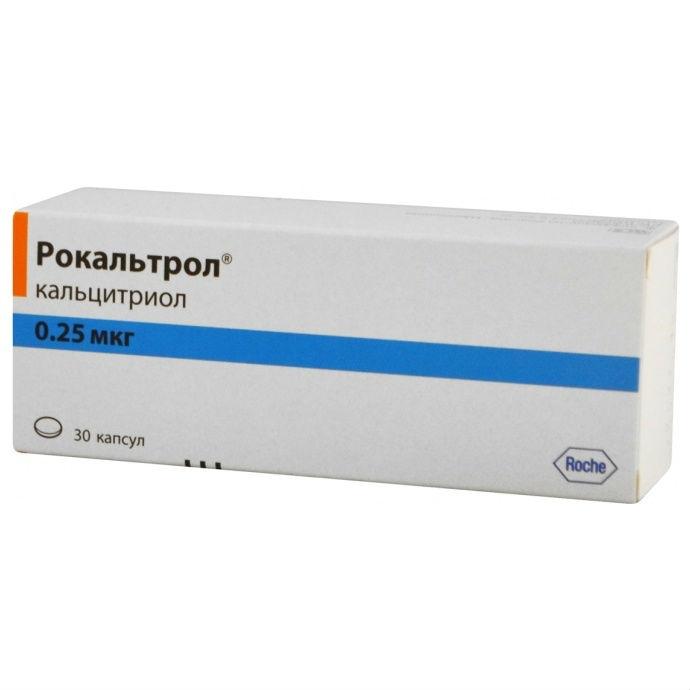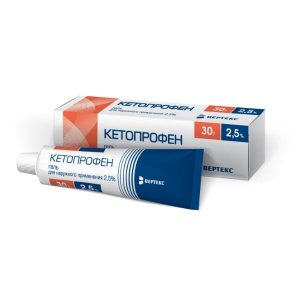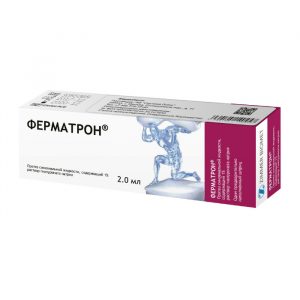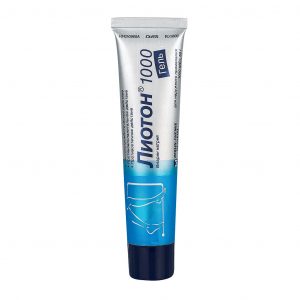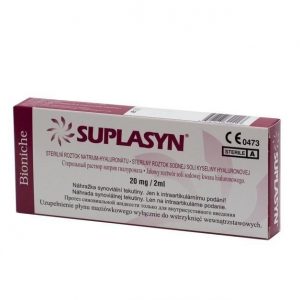Description
Latin name
Rocaltrol
Release form
Capsules.
Packing
30 pcs
Pharmacological action
Calcitriol is one of the most important active metabolites of vitamin D3. Calcitriol promotes the absorption of calcium in the intestines and regulates bone mineralization. The pharmacological effect of a single dose of calcitriol lasts 3-5 days.
The key role of calcitriol in the regulation of calcium metabolism, which consists in stimulating the activity of skeletal osteoblasts, is a reliable pharmacological basis for its therapeutic effect in osteoporosis.
In individuals with severe renal failure, the synthesis of endogenous calcitriol is reduced or may even stop altogether. Calcitriol deficiency plays a major role in the occurrence of renal osteodystrophy.
In patients with renal osteodystrophy, Rockaltrol (synthetic calcitriol) normalizes reduced absorption of calcium in the intestines, eliminates hypocalcemia, elevated levels of alkaline phosphatase and parathyroid hormone in the serum. It reduces pain in bones and muscles, and also eliminates the histological changes that occur with fibrous osteitis and other mineralization disorders.
In patients with postoperative and idiopathic hypoparathyroidism and pseudohypoparathyroidism, Rockaltrol reduces hypocalcemia and its clinical manifestations.
In patients with vitamin D-dependent rickets, serum calcitriol concentration is low or completely absent. Given the insufficient endogenous synthesis of calcitriol in the kidneys, taking Roctrol may be considered in patients such as replacement therapy.
In patients with vitamin D-resistant rickets and hypophosphatemia with low plasma calcitriol, Rockaltrol treatment reduces tubular excretion of phosphates and, in combination with phosphorus preparations, normalizes bone development.
Rockaltrol treatment also helps with other forms of rickets, such as those caused by neonatal hepatitis, biliary atresia, cystinosis, and nutritional deficiency of calcium and vitamin D.
Indications
Confirmed postmenopausal osteoporosis.
Renal osteodystrophy in patients with chronic renal failure, especially those on hemodialysis.
Secondary hyperparathyroidism in patients with moderate to severe degree of chronic renal failure (pre-dialysis).
Postoperative hypoparathyroidism.
Idiopathic hypoparathyroidism.
Pseudohypoparathyroidism.
Vitamin D-dependent rickets.
Hypophosphatemic vitamin D-resistant rickets (phosphate diabetes).
Contraindications
All diseases, hypercalcemia accompanied by hypersensitivity to the drug (or to drugs of the same class) or any other component of the drug hypervitaminosis D, children under 3 years of age.
Use during pregnancy and lactation
With oral administration of sublethal doses of vitamin D to pregnant rabbits, the fetus developed a valvular aortic stenosis. There are no data on the teratogenicity of vitamin D, even its very large doses. Roctrol should be prescribed to pregnant women only by absolute indications, if the expected effect for the mother outweighs the possible risk to the fetus.
Apparently, exogenous calcitriol passes into breast milk. Given the possible maternal hypercalcemia and adverse reactions in infants, taking the drug during breastfeeding is not recommended.
Composition of
One capsule contains: calcitriol – 0.25 μg
excipients: butylhydroxyanisole – 16.0 μg, butylhydroxytoluene – 16.0 μg, triglycerides medium chain up to 160.0 mg srdlkg, gelatin Carion 83 (contains 2-4% mannitol, 27-35% sorbitol, 61-71% hydrogenated hydrolyzed starch) – 11.56 mg, titanium dioxide (E171) – 0.33 mg, iron dye red oxide (E172) – 0.04 mg, iron oxide yellow oxide (E172) – 0.06 mg.
Dosage and Administration
Inside. The initial daily dose is 0.25 mcg. The optimal daily dose of Rockaltrol should be carefully selected for each patient, depending on the serum calcium content. Rockaltrol treatment should always be started with the lowest possible dose and increased only with careful monitoring of serum calcium levels.
A prerequisite for the optimal effectiveness of Rockaltrol therapy is a sufficient, but not excessive intake of calcium from food from the beginning of treatment (for adults – about 800 mg per day). In some cases, the patient may need to take calcium supplements. Due to improved absorption of calcium in the gastrointestinal tract, a reduced calcium intake may be sufficient for some patients receiving Rockaltrol. Patients with a tendency to hypercalcemia should be prescribed drugs only in small doses or even cancel them.
The total daily intake of calcium (with food and, if any, with medicines) should be, on average, approximately 800 mg and not exceed 1000 mg.
At the stage of stabilization of Rockaltrol therapy, serum calcium concentration should be determined at least twice a week. After selecting the optimal dose of Rockaltrol, serum calcium levels should be checked monthly (or according to the recommendations for individual indications, see below). Blood for calcium should be taken without using a tourniquet.
As soon as serum calcium levels of 1 mg / 100 ml (250 μmol / L) exceed the norm (9-11 mg / 100 ml or 2250-2750 μmol / L) or serum creatinine exceeds 120 μmol / L, Roctrol should be stopped immediately until the blood calcium levels normalize.
With hypercalcemia, serum calcium and phosphate levels should be determined daily. After their normalization, treatment with Rockaltrol can be continued, reducing the previous dose by 0.25 mcg. It is necessary to evaluate the daily intake of calcium with food and, if necessary, make adjustments to the diet.
Side effects of
Since Rockaltrol ® has vitamin D activity, its side effects are similar to those that occur with an overdose of vitamin D, i.e. hypercalcemia syndrome or calcium intoxication (depending on the severity and duration of hypercalcemia). Acute symptoms may include anorexia, headache, vomiting, gastralgia, or abdominal pain and constipation. Due to the short biological half-life of calcitriol, serum calcium levels normalize a few days after discontinuation of Rockaltrol ®, that is, much faster than when treated with vitamin D3 preparations.
With prolonged use, dystrophy, sensitivity disorders, fever, thirst, polyuria, dehydration, apathy can occur, growth retardation and urinary tract infections.
The frequency of each of the adverse reactions described in the clinical use of Rockaltrol ® for all indications over 15 years is very low (including hypercalcemia) and does not exceed 0.001%.
With simultaneous hypercalcemia and hyperphosphatemia> 6 mg / 100 ml or> 1.9 mmol / l, soft tissue calcification may occur, which is detected radiologically.
In patients with normal renal function, chronic hypercalcemia can lead to increased serum creatinine.
Sensitive individuals may develop hypersensitivity reactions (pruritus, rash, urticaria, and very rarely erythematous skin lesions).
Overdose
Treatment of asymptomatic hypercalcemia (see section Administration and dosage ).
Since Rockaltrol ® is a derivative of vitamin D, it is characterized by the same symptoms of overdose. Taking large doses of calcium and phosphate together with Rockaltrol ® can cause similar symptoms. The product of serum calcium and phosphorus (CaxP) concentration should not exceed 70 mg2 / dl2. The development of hypercalcemia can be facilitated by the high calcium content of dialysate.
Symptoms of acute vitamin D poisoning: anorexia, headache, vomiting, constipation.
Symptoms of chronic poisoning: dystrophy (weakness, weight loss), sensitivity disorders, fever with thirst, polyuria, dehydration, apathy, growth retardation and urinary tract infections are possible. The consequences of hypercalcemia are focal calcification of the cortical layer of the kidneys, myocardium, lungs, and pancreas.
Treatment of accidental overdose: immediate gastric lavage or vomiting to prevent further ingestion. Vaseline oil is used as a laxative to remove the drug with feces. It is recommended to re-determine serum calcium levels. If serum calcium is maintained, phosphates and corticosteroids can be prescribed, and take steps to ensure sufficient diuresis.
Storage conditions
Store at a temperature not exceeding 25 ° C in a dry, the place protected from light.
The Expiration of
is 3 years.
Deystvuyuschee substances
Kaltsypotryol
dosage form
dosage form
capsules
